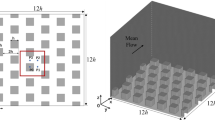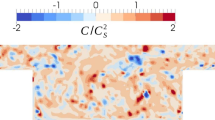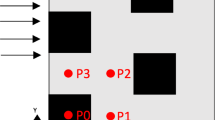Abstract
A coupling scheme is proposed for the simulation of microscale flow and dispersion in which both the mesoscale field and small-scale turbulence are specified at the boundary of a microscale model. The small-scale turbulence is obtained individually in the inner and outer layers by the transformation of pre-computed databases, and then combined in a weighted sum. Validation of the results of a flow over a cluster of model buildings shows that the inner- and outer-layer transition height should be located in the roughness sublayer. Both the new scheme and the previous scheme are applied in the simulation of the flow over the central business district of Oklahoma City (a point source during intensive observation period 3 of the Joint Urban 2003 experimental campaign), with results showing that the wind speed is well predicted in the canopy layer. Compared with the previous scheme, the new scheme improves the prediction of the wind direction and turbulent kinetic energy (TKE) in the canopy layer. The flow field influences the scalar plume in two ways, i.e. the averaged flow field determines the advective flux and the TKE field determines the turbulent flux. Thus, the mean, root-mean-square and maximum of the concentration agree better with the observations with the new scheme. These results indicate that the new scheme is an effective means of simulating the complex flow and dispersion in urban canopies.















Similar content being viewed by others
References
Allwine KJ, Flaherty JE (2006) Joint urban 2003—study overview and instrument locations. Pacific Northwest National Laboratory
Allwine KJ, Leach MJ, Stockham LW, Shinn JS, Hosker RP, Bowers RP, Pace JC (2004) J7. 1 Overview of Joint Urban 2003—an atmospheric dispersion study in Oklahoma City
Baik J-J, Park S-B, Kim J-J (2009) Urban flow and dispersion simulation using a CFD model coupled to a mesoscale model. J Appl Meteorol Climatol 48(8):1667–1681
Belcher SE, Coceal O, Goulart EV, Rudd AC, Robins AG (2014) Processes controlling atmospheric dispersion through city centres. J Fluid Mech 763:51–81
Brown MJ, Gowardhan AA, Nelson MA, Williams MD, Pardyjak ER (2013) QUIC transport and dispersion modelling of two releases from the Joint Urban 2003 field experiment. Int J Environ Pollut 52(3–4):263–287
Calhoun R, Gouveia F, Shinn J, Chan S, Stevens D, Lee R, Leone J (2004) Flow around a complex building: comparisons between experiments and a Reynolds-averaged Navier–Stokes approach. J Appl Meteorol 43(5):696–710
Castro FA, Silva Santos C, Lopes da Costa JC (2015) One-way mesoscale-microscale coupling for the simulation of atmospheric flows over complex terrain. Wind Energy 18(7):1251–1272
Chan ST, Leach MJ (2004) Large eddy simulation of an URBAN 2000 experiment with various time dependent forcing. Presented at the fifth symposium on the urban environment, Vancouver, BC, Canada
Chan ST, Leach MJ (2007) A validation of FEM3MP with Joint Urban 2003 data. J Appl Meteorol Climatol 46(12):2127–2146
Coceal O, Thomas TG, Castro IP, Belcher SE (2006) Mean flow and turbulence statistics over groups of urban-like cubical obstacles. Boundary-Layer Meteorol 121(3):491–519
Defraeye T, Blocken B, Carmeliet J (2011) An adjusted temperature wall wunction for turbulent forced convective heat transfer for bluff bodies in the atmospheric boundary layer. Build Environ 46(11):2130–2141
Dudhia J (1989) Numerical study of convection observed during the winter monsoon experiment using a mesoscale two-dimensional model. J Atmos Sci 46(20):3077–3107
Ehrhard J, Khatib IA, Winkler C, Kunz R, Moussiopoulos N, Ernst G (2000) The microscale model MIMO: development and assessment. J Wind Eng Ind Aerodyn 85(2):163–176
Goulart EV, Coceal O, Branford S, Thomas TG, Belcher SE (2016) Spatial and temporal variability of the concentration field from localized releases in a regular building array. Boundary-Layer Meteorol 159(2):241–257
Gousseau P, Blocken B, Stathopoulos T, Van Heijst GJF (2011) CFD simulation of near-field pollutant dispersion on a high-resolution grid: a case study by LES and RANS for a building group in downtown Montreal. Atmos Environ 45(2):428–438
Grötzbach G (1987) Direct numerical and large eddy simulation of turbulent channel flows. In: Cheremisinoff NP (ed) Encyclopedia of fluid mechanics, pp 1337–1391
Hanna SR, Hansen OR, Dharmavaram S (2004) FLACS CFD Air Quality Model performance evaluation with Kit Fox, MUST, Prairie Grass, and EMU observations. Atmos Environ 38(28):4675–4687
HŒPffner J, Naka Y, Fukagata K (2011) Realizing turbulent statistics. J Fluid Mech 676:54–80
Hong SY, Noh Y, Dudhia J (2006) A new vertical diffusion package with an explicit treatment of entrainment processes. Mon Weather Rev 134(9):2318–2341
Kim JJ, Baik J-J (2003) Effects of inflow turbulence intensity on flow and pollutant dispersion in an urban street canyon. J Wind Eng Ind Aerodyn 91(3):309–329
Krayenhoff ES, Santiago JL, Martilli A, Christen A, Oke TR (2015) Parametrization of drag and turbulence for urban neighbourhoods with trees. Boundary-Layer Meteorol 156(2):157–189
Kwak K-H, Baik J-J, Ryu Y-H, Lee S-H (2015) Urban air quality simulation in a high-rise building area using a CFD model coupled with mesoscale meteorological and chemistry-transport models. Atmos Environ 100:167–177
Lalic B, Mihailovic DT (2004) An empirical relation describing leaf-area density inside the forest for environmental modeling. J Appl Meteorol 43(4):641–645
Larsén XG, Larsen SE, Petersen EL (2016) Full-scale spectrum of boundary-layer winds. Boundary-Layer Meteorol 159(2):349–371
Leonardi S, Castro IP (2010) Channel flow over large cube roughness: a direct numerical simulation study. J Fluid Mech 651:519–539
Li H, Cui G, Zhang Z (2017) Development of inflow turbulence in microscale urban atmospheric environment. Appl Math Mech 38:1377–1396
Liu YS, Miao SG, Zhang CL, Cui GX, Zhang ZS (2012) Study on micro-atmospheric environment by coupling large eddy simulation with mesoscale model. J Wind Eng Ind Aerodyn 107–108:106–117
Lund TS, Xiaohua Wu, Squires KD (1998) Generation of turbulent inflow data for spatially-developing boundary layer simulations. J Comput Phys 140(2):233–258
Meneveau C, Lund TS, Cabot WH (1996) A Lagrangian dynamic subgrid-scale model of turbulence. J Fluid Mech 319:353–385
Miao Y, Liu S, Chen B, Zhang B, Wang S, Li S (2013) Simulating urban flow and dispersion in Beijing by coupling a CFD model with the WRF model. Adv Atmos Sci 30(6):1663–1678
Michioka T, Sato A (2012) Effect of incoming turbulent structure on pollutant removal from two-dimensional street canyon. Boundary-Layer Meteorol 145(3):469–484
Michioka T, Sato A, Sada K (2013a) Large-eddy simulation coupled to mesoscale meteorological model for gas dispersion in an urban district. Atmos Environ 75:153–162
Michioka T, Takimoto H, Sato A (2013b) Large-eddy simulation of pollutant removal from a three-dimensional street canyon. Boundary-Layer Meteorol 150(2):259–275
Mlawer EJ, Taubman SJ, Brown PD, Iacono MJ, Clough SA (1997) Radiative transfer for inhomogeneous atmospheres: RRTM, a validated correlated-k model for the longwave. J Geophys Res Atmos 102(D14):16663–16682
Nakayama H, Takemi T, Nagai H (2012) Large-eddy Simulation of urban boundary-layer flows by generating turbulent inflows From mesoscale meteorological simulations. Atmos Sci Lett 13(3):180–186
Nelson MA, Brown MJ, Halverson SA, Bieringer PE, Annunzio A, Bieberbach G, Meech S (2016a) A case study of the Weather Research and Forecasting model applied to the Joint Urban 2003 tracer field experiment. Part 1: wind and turbulence. Boundary-Layer Meteorol 158(2):285–309
Nelson MA, Brown MJ, Halverson SA, Bieringer PE, Annunzio A, Bieberbach G, Meech S (2016b) A case study of the Weather Research and Forecasting model applied to the Joint Urban 2003 tracer field experiment. Part 2: Gas tracer dispersion. Boundary-Layer Meteorol 161(3):461–490
Noilhan J, Planton S (1989) A simple parameterization of land surface processes for meteorological models. Mon Weather Rev 117(3):536–549
Park S-B, Baik J-J, Lee S-H (2015) Impacts of mesoscale wind on turbulent flow and ventilation in a densely built-up urban area. J Appl Meteorol Climatol 54(4):811–824
Raupach MR, Antonia RA, Rajagopalan S (1991) Rough-wall turbulent boundary layers. Appl Mech Rev 44(1):1–25
Skamarock WC, Klemp JB, Dudhia J, Gill DO, Barker DM, Duda MG, Huang X-Y, Wang W, Powers JG (2008) A description of the advanced research WRF Version 3. NCAR Tech. Note NCAR/TN-475+STR
Tewari M, Kusaka H, Chen F, Coirier WJ, Kim S, Wyszogrodzki AA, Warner TT (2010) Impact of coupling a microscale computational fluid dynamics model with a mesoscale model on urban scale contaminant transport and dispersion. Atmos Res 96(4):656–664
Van der Hoven I (1957) Power spectrum of horizontal wind speed in the frequency range from 0.0007 to 900 cycles per hour. J Meteorol 14(2):160–164
Wyszogrodzki AA, Miao S, Chen F (2012) Evaluation of the coupling between mesoscale-WRF and LES-EULAG models for dimulating fine-scale urban dispersion. Atmos Res 118:324–345
Xie Z-T (2011) Modelling street-scale flow and dispersion in realistic winds—towards coupling with mesoscale meteorological models. Boundary-Layer Meteorol 141(1):53–75
Xie Z-T, Castro IP (2006) LES and RANS for turbulent flow over arrays of wall-mounted obstacles. Flow Turbul Combust 76(3):291–312
Xie Z-T, Castro IP (2008) Efficient generation of inflow conditions for large eddy simulation of street-scale flows. Flow Turbul Combust 81(3):449–470
Acknowledgements
This study is sponsored by the National Natural Science Foundation of China (NSFC Grant 11132005, 11490551).
Author information
Authors and Affiliations
Corresponding author
Rights and permissions
About this article
Cite this article
Li, H., Cui, G. & Zhang, Z. A New Scheme for the Simulation of Microscale Flow and Dispersion in Urban Areas by Coupling Large-Eddy Simulation with Mesoscale Models. Boundary-Layer Meteorol 167, 145–170 (2018). https://doi.org/10.1007/s10546-017-0323-5
Received:
Accepted:
Published:
Issue Date:
DOI: https://doi.org/10.1007/s10546-017-0323-5




